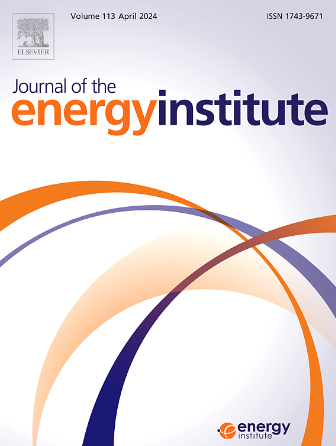富氢氧预室喷射点火增强预混合氨燃烧
IF 6.2
2区 工程技术
Q2 ENERGY & FUELS
引用次数: 0
摘要
预室湍流射流点火在改善氨燃烧方面具有重要的潜力。预室富氢富氧燃烧能进一步促进氨的燃烧。然而,对这种增强燃烧机理的基础研究仍然有限。本研究系统地考察了富氧多孔预室中富氧燃烧和喷嘴几何规格对非反应环境下射流行为的个别影响,以及射流行为对反应环境下氨点火行为、燃烧过程和排放的影响。结果表明,富氧显著提高了点火特性,当氧浓度从体积比30%增加到70%时,出现了三种点火模式:局部再点火、射流诱导二次点火和射流火焰点火。随着氧浓度的增加,燃烧持续时间先减小后增大。随着氧的富集,未燃烧NH3和N2O排放量减少,而NOx排放量略有增加。在预室喷管设计中,两个具有相同累积孔口面积的喷管,即6个1.50 mm孔口和3个2.12 mm孔口,表明较大的孔口有利于氨点火。另一方面,当两个喷嘴具有相同的孔直径时,具有较小累积孔面积的喷嘴可以增强点火行为,因为它可以产生更高速度的热射流。对于两个孔数相同且热射流速度相近的喷嘴,孔数较大的喷嘴表现出更好的点火性能。这些发现可以为增强氨燃烧和优化喷嘴设计提供有价值的见解。本文章由计算机程序翻译,如有差异,请以英文原文为准。
Enhanced premixed ammonia combustion by hydrogen-oxygen enriched pre-chamber jet ignition
Pre-chamber turbulent jet ignition holds significant potential for improving ammonia combustion. Hydrogen- and oxygen-enriched combustion in the pre-chamber can further enhance ammonia combustion. However, fundamental research on this enhanced combustion mechanism remains limited. This study systematically examines the individual impacts of oxygen-enriched combustion in a hydrogen-enriched multi-orifice pre-chamber and nozzle geometry specifications on jet behavior in a nonreactive environment, as well as the impact of the jet behavior on ammonia ignition behavior, combustion processes, and emissions in a reactive environment. The results show that oxygen enrichment significantly enhances ignition characteristics, with three ignition modes observed as the oxygen concentration increases from 30 % to 70 % by volume: localized re-ignition, jet-induced secondary ignition, and jet flame ignition. With increasing oxygen concentration, combustion duration decreases initially and then increases. Unburned NH3 and N2O emissions decrease, while NOx emissions slightly increase with oxygen enrichment. In the pre-chamber nozzle design, two nozzles with identical cumulative orifice areas, i.e., six 1.50 mm orifices and three 2.12 mm orifices, demonstrate that larger orifices improve ammonia ignition. On the other hand, when both nozzles have an identical orifice diameter, the nozzle featuring a smaller cumulative orifice area enhances ignition behavior as it generates higher-velocity hot jets. For two nozzles featuring the same number of orifices and similar hot jet velocities, the nozzle featuring the larger orifice demonstrates superior ignition behavior. These findings could offer valuable insights into enhancing ammonia combustion and optimizing nozzle design.
求助全文
通过发布文献求助,成功后即可免费获取论文全文。
去求助
来源期刊

Journal of The Energy Institute
工程技术-能源与燃料
CiteScore
10.60
自引率
5.30%
发文量
166
审稿时长
16 days
期刊介绍:
The Journal of the Energy Institute provides peer reviewed coverage of original high quality research on energy, engineering and technology.The coverage is broad and the main areas of interest include:
Combustion engineering and associated technologies; process heating; power generation; engines and propulsion; emissions and environmental pollution control; clean coal technologies; carbon abatement technologies
Emissions and environmental pollution control; safety and hazards;
Clean coal technologies; carbon abatement technologies, including carbon capture and storage, CCS;
Petroleum engineering and fuel quality, including storage and transport
Alternative energy sources; biomass utilisation and biomass conversion technologies; energy from waste, incineration and recycling
Energy conversion, energy recovery and energy efficiency; space heating, fuel cells, heat pumps and cooling systems
Energy storage
The journal''s coverage reflects changes in energy technology that result from the transition to more efficient energy production and end use together with reduced carbon emission.
 求助内容:
求助内容: 应助结果提醒方式:
应助结果提醒方式:


